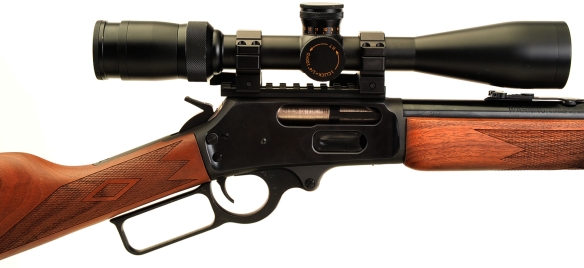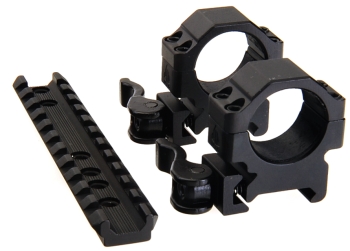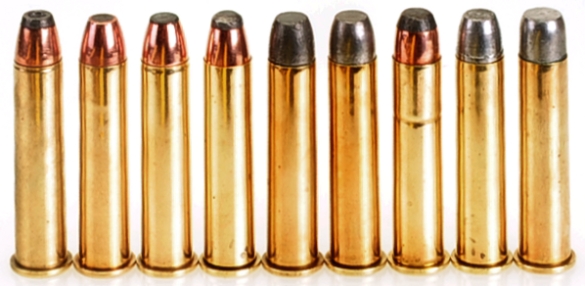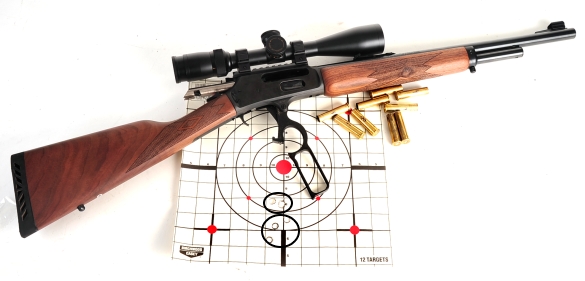The conclusion reached in Part 1 was that current Marlin Model 1895 product assembled in Remington’s Ilion, NY facility demonstrated that Remington has a handle on the lever gun’s production quality and there are a lot of good things ahead. Point by point, this example had none of the ailments of the gun we had reviewed several months ago. So we went on to assess the Guide Gun’s live fire performance.

It is tough to not have fun with a Marlin 1895G. It is one of the most comfortable little guns to shoot and it is a boomer. Over a decade ago, when I purchased my first Guide Gun, one of the first things I did was replace the recoil pad as an act of self-defense. That wasn’t the case, this time around, as the recoil pad did a good job absorbing the jolt from anything I was shooting. The pad does appear to be made with a softer compound. To take my metallic sight limitations out of the accuracy equation, a 2-10x scope was mounted, trying a couple of different types of mount systems.
NcStar & UTG… My apologies to the Marlin Guide Gun
Every once in a while I step out of the norm to try other products; types and brands. In this case, I tried an NcStar mount and UTG quick detach rings as an approach to mounting a scope while maintaining the options of quick removal and use of metallic sights. I like to use Picatinny rails and rings because they provide the most latitude in scope placement and the components key together, locking scope related mass together and firmly to a firearm.
The Mil-STD-1913 Picatinny mount rail design drawing calls out dimensions of 0.206″x0.835″x0.164″ for each recoil groove. The rail’s active clamping surfaces is 0.367″ high. Weaver recoil grooves are smaller; 0.150″x0.835″x0.105″ with an active clamping height of 0.210″. At least that is what measuring over 200 sets of Weaver rails from virtually every manufacturer, including Weaver, indicate. I have seen 0.180″ referenced in place of 0.150″, but never substantiated with an engineering drawing or a part that actually measure 0.180″.
 The NcStar MMLIN piece is listed as a Weaver style rail, but its recoil grooves measure 0.206″x0.835″x0.100″ and the active clamping height is 0.225″.
The NcStar MMLIN piece is listed as a Weaver style rail, but its recoil grooves measure 0.206″x0.835″x0.100″ and the active clamping height is 0.225″.
The example in this case was made of aluminum, powder coated, not anodized. The hole spacing was off and the fasteners were cheaply made; too short for the application and undersized. Additionally, the mount holes were drilled oversize relative to the fasteners. While this gave some latitude for adjustment to overcome the misalignment with receiver hole locations holes, this slop also allowed mount movement under recoil.
Regardless how the mount was oriented to the holes in the receiver, the mount either overhung the receiver to the rear and obstructed access to the gun’s hammer (See very top photo) or it overhung the gun’s barrel and looked… unpleasant. Either way, it was NcStar’s attempt at a one part fits all solution that diminished the appearance of the firearm. After twenty rounds, the scope was pulled and bare metal was exposed where rings dug into the mount’s soft aluminum and movement against the receiver top transferred aluminum from the mount to the gun’s finish.
The UTG quick detach rings were labeled and advertised as Picatinny standard, but were not. They were also not effectively cross pinned and the latching levers were huge. The round cross pins put a shallow radius against the mount’s square shoulder, which tended to lift the ring out of the slot on recoil rather than positively locate it fore and aft. I believe this contributed to the rail damage. In any event, back to Warnes steel mounts and rings.
Ammunition – No home brew
I felt I had an obligation to shoot this gun, and to shoot it a lot. Mainstream factory loaded ammo was used so that anything done here can be duplicated by anyone. Pictured below is about $2.6 million worth of specialized 45-70 ammunition, the equivalent of about $2 worth of handloads.

Why ballistic tables when data can be pulled from the manufacturer’s documentation or a reloading manual? Because the barrel length standard published by ammunition manufacturers is often different than the rifle in hand and because reloading manuals often reflect the same data skew and component variables can yield data that is +/- 150 fps.
|
Ammunition |
Bullet Grains |
Bullet Type |
Pressure Level |
Mfg MV FPS |
Mfg ME ft/lbs |
Actual MV FPS |
Actual ME Ft/Lbs |
100 Yd 3 Shot Group “ |
$/20 |
| Winchester X | 300 | JHP | SAAMI | 1880 | 2355 | 1648 | 1810 | 1.2 | 32 |
| Winchester Supreme | 300 | Partition Gold | SAAMI | 1880 | 2355 | 1636 | 1783 | 1.0 | 40 |
| HSM | 350 | Swift A Frame | Hi-Perf | 2050 | 3267 | 2108 | 3454 | 1.0 | 48 |
| Buffalo Bore | 350 | JFN | Hi-Perf | 2150 | 3593 | 2127 | 3517 | 1.2 | 50 |
| Ultramax | 405 | Cast FN | SAAMI | 1100 | 1088 | 1092 | 1073 | 1.4 | 35 |
| Black Hills | 405 | Cast FN | SAAMI | 1250 | 1406 | 1204 | 1304 | 1.5 | 29 |
| Remington Express | 405 | JSP | SAAMI | 1330 | 1590 | 1175 | 1242 | 0.8 | 40 |
| Buffalo Bore | 430 | Cast FN | Hi-Perf | 1925 | 3539 | 1886 | 3397 | 1.3 | 56 |
| Garrett Hammerhead | 540 | Cast FN | Hi-Perf | 1550 | 2881 | 1532 | 2815 | 1.6 | 80 |
Ammunition appears on the table in bullet weight order, sub sorted in velocity order. There are some loads that obviously would be excellent for woodland deer hunting and certainly hog hunting. Light on recoil, accurate and with tough bullets. At the big end, the energy levels are at least the equivalent of the 300 WSM and 325 WSM and knocking on the door of the 338 Winchester Magnum, all magnums fired from 24″ barrels. Of course the .458″ bullet makes a huge wound channel by comparison and the Garrett round is the king of penetration with six feet of penetration in wet newspaper. More than the 458 Winchester and more than the 458 Lott.
If factory ammunition doesn’t do it for you, there are lots of jacketed and milder cast bullet handloads that will produce similar or even better results and save a bunch of cash in the process. The 45-70 Gov’t, when treated respectfully, is a handloader’s cartridge and it doesn’t take more than the little Guide Gun’s 18 1/2″ barrel to make it shine.
A 100 yard myth?
The original 45-70 Gov’t cartridge earned its reputation in 1,000 yard competitive shooting, however, rainbow trajectory, critical range estimating requirements and low terminal energy have few benefits in hunting situations. Based upon trajectory and terminal energy, the 45-70 definitely has 200 yard hunting potential. However, beyond 200 yards, the large bullet diameter, low ballistic coefficient and velocity conspire to slow things down. The following tables were generated based up the best zero for the greatest point blank range.
|
Indices |
300 Grain Winchester X – SAAMI | ||||||
| Range -yds | 0 | 50 | 100 | 150 | 200 | 250 | 300 |
| Velocity – ft./sec. | 1648 | 1555 | 1467 | 1385 | 1308 | 1241 | 118 |
| Energy – ft.-lbs. | 1809 | 1610 | 1433 | 1277 | 1140 | 1025 | 927 |
| Path – in. | -1.5 | 2.4 | 2.6 | -1.1 | -9.5 | -22.8 | -41.9 |
|
Hog, Deer and other thin skinned game |
|||||||
|
Indices |
350 Grain HSM – High Performance | ||||||
| Range -yds | 0 | 50 | 100 | 150 | 200 | 250 | 300 |
| Velocity – ft./sec. | 2108 | 1885 | 1677 | 1489 | 1325 | 1191 | 1089 |
| Energy – ft.-lbs. | 3453 | 2761 | 2184 | 1723 | 1364 | 1102 | 921 |
| Path – in. | -1.5 | 2.0 | 3.0 | 0.9 | -5.2 | -16.2 | -33.3 |
|
Elk, Moose, Black Bear |
|||||||
| Indices | 540 Grain Hammerhead | ||||||
| Range -yds | 0 | 50 | 100 | 150 | 200 | 250 | 300 |
| Velocity – ft./sec. | 1532 | 1402 | 1285 | 1188 | 1108 | 1046 | 996 |
| Energy – ft.-lbs. | 2814 | 2355 | 1981 | 1691 | 1473 | 1311 | 1190 |
| Path – in. | -1.5 | 2.5 | 2.1 | -3.5 | -15.3 | -34.2 | -61.0 |
|
Big Bear – Close In – Penetrating Round |
|||||||
Perspective….
| Indices | 308 Winchester 180 grain | ||||||
| Range -yds | 0 | 50 | 100 | 150 | 200 | 250 | 300 |
| Velocity – ft./sec. | 2620 | 2514 | 2410 | 2310 | 2211 | 2116 | 2022 |
| Energy – ft.-lbs. | 2743 | 2525 | 2322 | 2132 | 1954 | 1789 | 1634 |
| Path – in. | -1.5 | 1.1 | 2.2 | 1.9 | -0.0 | -3.7 | -9.4 |
| Heavy 308 Winchester Load – Elk, Moose | |||||||
The little 308 Winchester, with a heavy 0.308″ bullet for heavy game, moves ahead of the 45-70 Gov’t round, including the heavy 45-70 Gov’t loads, beyond one hundred yards. The 308 Winchester has nearly twice the retained velocity and kinetic energy at 300 yards. Trajectory isn’t even close over the longer haul. But stubby little carbines are not intended for long ranges and open spaces and there are many more hunting situation where the 45-70 Gov’t will grossly out perform the 308 Winchester.
Inside 150 yards, the 45-70 Gov’t is bone crushing and tough controlled expansion or hard cast deep penetrating bullets can open a large wound channel. There is no place in North America, and no game of any type, that could not be hunted in confidence with the Marlin Model 1895 Guide Gun and the 45-70 Gov’t.
When Marlin Model 1895G and 45-70 Gov’t ammo combine…
I’m glad we got to take another look at the Guide Gun at this stage of production transition and to see how well things have progressed. Contrary to the opinion of some folks out there, everyone doesn’t get excited about reviewing firearms. It takes staff away from critical shop work, handloading and gunsmithing projects. Personally, fifty-five years of shooting firearms has conditioned me to not go all tingly when someone suggests that I take a week out of my life to assess the virtues of a firearm. This time, I enjoyed the project.

There are so many places the 1895G fits in for a hunter. Open sights or scopes, loaded light or literally loaded for bear, this is an extremely flexible combination. The Guide Gun is light, it holds up to being flogged and it looks good. The finish quality these days is excellent, accuracy rivals many bolt guns and the price is right. How sincere is this assessment? I bought this rifle and you’ll see it often on Real Guns.
Marlin Under Remington Stewardship Part I
Marlin Under Remington Stewardship Part II
Marlin’s Official Website

Email Notification